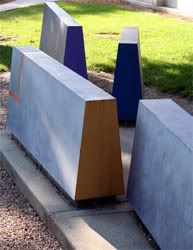 In looking at the sculpture Variable Wedge by Sam Richardson, there are many rhetorical techniques, strategies, and concepts utilized to make certain appeals to its audience. When one first observes the sculpture, the first thing that the eye notices is the form of the "wedge," and how the title plays into this form. The sculpture consists of seven separate sections of a wedge, or triangular-shaped form as viewed from the side, which has the cross section of a regular trapezoid. When viewed from the side (North or South views), it appears as a complete wedge. When looked at from any other view, however, one notices that the fifth and sixth sections within this wedge sort of branch out from the linear pattern established within the first four sections. The fifth is rotated so that it is branches out toward the North, while the sixth one branches out toward the South. Finally, then, the seventh section is oriented in-line with the first four sections, as it is back on track. This form, whose title makes sense with the orientation of the piece, begins to possibly establish a narrative for the entire sculpture, one of progression from small to large through time: possibly even growth. The trapezoidal cross-section, however, as well as the geometric shape appeal to logos, as it is a stable form, with a large base.
In looking at the sculpture Variable Wedge by Sam Richardson, there are many rhetorical techniques, strategies, and concepts utilized to make certain appeals to its audience. When one first observes the sculpture, the first thing that the eye notices is the form of the "wedge," and how the title plays into this form. The sculpture consists of seven separate sections of a wedge, or triangular-shaped form as viewed from the side, which has the cross section of a regular trapezoid. When viewed from the side (North or South views), it appears as a complete wedge. When looked at from any other view, however, one notices that the fifth and sixth sections within this wedge sort of branch out from the linear pattern established within the first four sections. The fifth is rotated so that it is branches out toward the North, while the sixth one branches out toward the South. Finally, then, the seventh section is oriented in-line with the first four sections, as it is back on track. This form, whose title makes sense with the orientation of the piece, begins to possibly establish a narrative for the entire sculpture, one of progression from small to large through time: possibly even growth. The trapezoidal cross-section, however, as well as the geometric shape appeal to logos, as it is a stable form, with a large base.The second element about the sculpture that is hard to miss are the elements of color located on the sides of the slices: as if someone had taken a saw colored with paint and cut the big wedge up into smaller pieces. These hues make an appeal to pathos, as they are vibrant colors: relatively bright with a lot of saturation. These possibly refer to the core or inner values within people, which can especially be seen when people stray off of the normal path. Due to their vibrant nature, these colors emit a sense of energy to them, especially since they are juxtaposed with the cool gray that engulfs the outside surface of the sculpture. The material also becomes important, as the piece of art is composed of Cor-Ten Steel, which is smooth, but geometric looking. The fact that the sculpture is located outside adds to this effect, as the gray surfaces are noticeably weathered, with rust forming on them. These colored sections are not, however, which makes them all the more vibrant in comparison.
The last element that is extremely noteworthy, especially considering Sam Richardson's background with landscaping elements, is the environment in which the sculpture is located. Situated in a position parallel and in between the Westbrook Music Building and Architecture Hall, the sculpture seems to discuss the subjects of these two buildings. The form of the wedge seems to depict a progression through life, addressing how professionals such as musicians and architects sometimes need to branch off from the main road in order to show their talents, or colors.
No comments:
Post a Comment